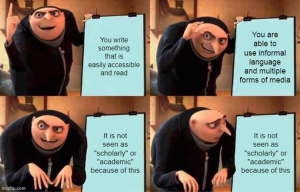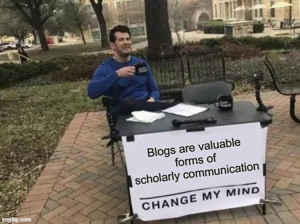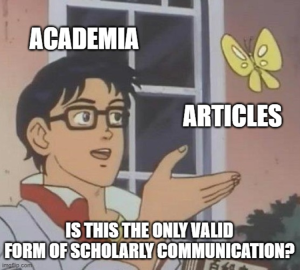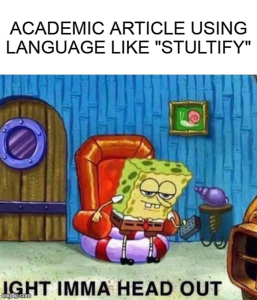18 A Blog Post About Blogs
G.W. Currier and Kennedy Essmiller
Because of the value placed on more “rigorous” methods of publication such as peer reviewed journals by academia, there is something of a prejudice against modes of communication such as blogs. Blogs can be recursive, ever-changing modes of communication, while articles have to go through the more rigorous—and therefore more time-consuming—process of peer review and publication. Because of this, blogs can keep up with the most current of information, while articles are subject to the timeline of journals.
As a writer, one of the most important things for you to learn how to do is how to identify your target audience. Writing is one way you can share your voice, your experiences, and your opinions with others. Who do you write for? Instinctively, especially as a student in a classroom, you might think that you are writing for your instructor. It’s time to rethink this notion.
Different forms of writing target different audiences. A post you make on social media includes writing—how many minutes did you spend coming up with a caption?—and it has a specific audience. Similarly, blogs and articles have specific expected audiences. When you think of the intended audience for a journal article, who do you think of? It might be students, like yourselves, or it might be experts in that journal’s particular field. Oftentimes, we consider the target audience of an article to be more academic, or more scholarly.
On the other hand, who is the intended audience for a blog? When you think of a blog, do you think of a recipe blog, or of a blog dedicated to rating different restaurants? Certainly, these are valuable blogs. However, do you consider them to be scholarly or of academic value? You might think not, for a variety of reasons. Articles go through a peer review process and are written by experts in the field. Blogs are written by anyone and everyone, and they can be posted immediately online.
Does that mean they aren’t as valuable?
This section seeks to reposition the blog as a valid and important form of writing.
Why do we learn how to write? Joseph Teller (2016), a seasoned composition instructor, complained of his students not being able to write “a clear sentence to save their lives.” He continued, saying, “the more time a course focuses on ‘critical reading’ and content, the less time it spends on structure, argument, evidence, logical reasoning, and concise, clear prose—the tools a composition class should give undergraduates” (Teller 2016). These might be the teacher’s primary objectives, but does learning like this in such an academic straightjacket prevent students from practicing other aspects of communication?
In a response to Teller (2016), Emily Shearer Stewart (2016) argued, “Simply teaching the technical skills of writing supposes that writing is just that—a skill—rather than an art.” Communication is not black and white, and we must re-examine our priorities as writers if we continue to insist that there is a standard way of communicating information and those who do not conform to it are not as valuable.
Blogs are not subject to the same sort of gatekeeping and standardization that articles are. This does not mean that one is better than the other—it simply means that, as Stewart (2016) claims, writing is an art, and therefore there should not be a standardized way of communication that is inherently more valuable.
Much like this section, blogs often incorporate informal language. This is language that is accessible to readers regardless of educational background. In contrast, articles include academic language that can often be challenging even for readers with an extensive educational background.
We challenge you to consider this: Does more formal and academic language correlate with inherent value? Let me put it another way. Do fancier words mean that what you are saying is more important than if you said it with more accessible words?
In addition to informal language, blogs can integrate media that are often found lacking in articles, such as interactive links, popular gifs or memes, and images. Again, we challenge you to think about whether or not the presence of media such as popularized memes lessens the value of what the blog offers or what the author has to say. We think not, and we seek to show you how the multimodal (the method of using different modes such as textual, aural, linguistic, spatial, and visual, for communication and meaning-making, according to Gunther Kress [2003]) platform of a blog can add to rather than detract from the blog’s message.
We argue that the multimodal aspects of the blog can serve to enhance, rather than diminish, the message that a blog’s author has to share. For example, memes are a useful and ever changing form of communication that is widespread on the internet. Because of this, citizens of the internet are often fluent in this “language” of images and text, using the context as well as the history of how the images have been used to determine their meaning. In addition to images and memes, blogs are able to incorporate live links to immediately reference other sources or information. For example, the inclusion of this link allows readers to immediately access an important source that all students and teachers alike can appreciate. Rather than the more traditional citations that are found in articles, live links can redirect readers who are interested in learning more about a specific topic as they read the blog.

Take this image, for example. Writing the words “You write something that is easily accessible and read. You are able to use informal language and multiple forms of media. It is not seen as ‘scholarly’ or ‘academic’ because of this” will communicate the surface level of what it means. However, paired with the image that has a history of being used to point out something surprising or unexpected, the text takes on another level of meaning.

This image has commonly been used as a way for the user or poster (the author) to communicate that, while they say “change my mind,” they are truthfully saying that it will not be easy nor plausible to change their mind on the topic. Without the image and the context of it, this meaning would be lost. Articles often use language and text, sometimes going so far as to incorporate relevant images or to group the text in such a way to emphasize it, but they do not have the freedom that blogs do to utilize these memes to communicate multiple levels of information.


These images above reveal how communication can have multiple levels. If you were to read the words independent of the image, some meanings would be lost. Additionally, because there is a cultural context within which these images take on additional meanings, so does the text itself. Each of these images argues against placing a premium on articles and valuing them as forms of communication over the more informal blog. They look at how the use of language or accessibility of a piece shouldn’t necessarily determine the validity of that piece of communication. This use of images and text show how multimodal forms of communication, such as those found within a blog post, can add layers of meaning for your readers.
Additionally, blogs can be utilized within the classroom as a way for students like yourselves to communicate with one another as peers as well as with your instructor. Not only is the blog a valuable form of communication, it is a low-stakes way of exploring ideas talked about in the classroom. Because of the removal of the pressure that accompanies articles, blogs allow students to more comfortably and confidently express their ideas and voices. Blogs that are utilized throughout the entirety of a semester can also provide students with a way to visibly keep track of their process and improvement as writers. Often, it can be challenging to see the difference a semester can make in one’s writing. However, with the blog format, students can see the changes in their voice and writing processes over the course of the semester. Finally, due to the nature of the blog format, students can reference previous ideas and thoughts and show how they’ve expanded upon or changed those ideas. We, the authors of this section, have personally had experience both as students and instructors using the blog over the course of the semester, so we can confirm first hand these benefits of the blog format.
References:
Kress, G. (2003). Literacy in the new media age. Routledge.
Teller, J. R. (2016). Are we teaching composition all wrong? The Chronicle of Higher Education.
Stewart, E. S. (2016). No, we’re not teaching composition “all wrong.” The Chronicle of Higher Education.

